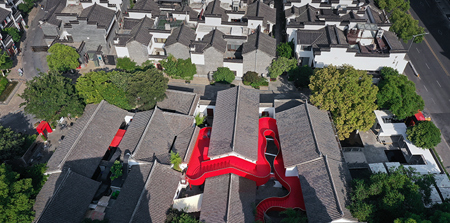

Big Red Crayfish
Dayi Design
At the heart of the design is a red streamlined steel staircase, which unites four buildings (two two-story and two one-story) into a cohesive whole. The sinuous, dragon-like form of the staircase serves not only as a striking visual element but also provides practical functions, including a fire escape and shelter for logistics during inclement weather. Its bright red color aligns with the "Big Red Crayfish" restaurant theme, enhancing the sensory experience and drawing visitors into the space. These buildings were first built over 300 AD and once the residence of Xie An, a prominent figure of the Eastern Jin Dynasty, have been carefully repaired to preserve their historical integrity. Modern interventions, such as the sculptural staircase and repurposed materials, have been incorporated to address functional challenges. For example, removed doors were repurposed as glass screens, and original Taihu stones were reorganized to serve as functional barriers, further connecting the site’s rich history with contemporary design. The staircase not only connects the various levels but also acts as a sheltered space for guests to wait or for staff to transport food in adverse weather conditions. The platform offers new perspectives of the nearby Dabaoen Temple, taking full advantage of the site’s unique geographic advantages and enriching the visitor experience with unexpected views. LED display devices have been integrated into the design to bring energy and motion to the space, creating dynamic visual focal points that help unify the various elements of the project. The overall aesthetic blends traditional Chinese architecture with modern materials like metal and glass, creating a striking contrast between ancient forms and contemporary design, encapsulating the philosophy of “Cyber Chinese Style.” Through careful design and minimal intervention, the project successfully preserves the historical value of the buildings while adapting them for modern use, making them accessible and functional while also providing a unique, immersive experience. The design enhances the space’s commercial and cultural potential, ensuring its sustainability and continued relevance in the future.